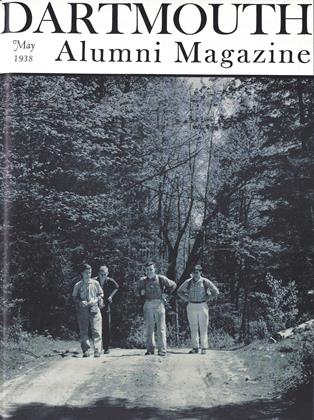by Thomas Thacher, Facsimile Reproductions of the Three Known Editions with an Introductory Note by Henry R. Viets, M. D.'12. Baltimore, The Johns Hopkins Press, 1937. p. 70. 11.50. A publication of the Institute of the History of Medicine, The Johns Hopkins University, Fourth Series, Bibliotheca Medica Americana, Volume I.
The author of this booklet has previously shown his interest and knowledge of the history of medicine in the early years of the American Colonies as shown by his volume-, A Brief History of Medicine in Massachusetts, 1930, which was reviewed in this MAGAZINE. The small volume here under consideration presents a reproduction of the earliest medical document printed in America, north of Mexico, written by Thomas Thacher, and published in Boston by John Foster in January, 1678. Also reproduced are a reprinting of this document in 1702 and a third printing dated 1721-2. The two reprintings have never before been reproduced since they were originally issued and the latter (the last known printing of the original paper) has been practically unknown in medical history, while the date of its publication has been definitely set. Whereas the two reprintings were in small pamphlet form the original appeared as a broadside, and all three are rare and fine examples of early American printing, one copy only of each being known to exist.
The actual reproductions occupy about one quarter of the pages of this little volume and though the Brief Rule is of interest for its own sake it is the reading of the introduction that gives us the significance of this more than two hundred and fifty year old paper. It is a medical treatise, printed for the vital need of the people of Massachusetts in 1678 in order that they might be able to identify the appearance of smallpox in their midst, and, so far as possible at that time, to combat its ravages. Each of the three printings was related to the outbreak of an epidemic of this disease, the last of the three on an occasion when about six thousand cases of smallpox occurred in Boston, one of seven of whom died.
The broadside was not written by a physician but by a clergyman, Thomas Thacher, minister of the Third Church of Boston, and this fact illustrates the almost complete lack of doctors at that time in this country. A large share of what medical practice existed was handled by the most educated among the colonists, found among the clergy.
The greatest value of this document in medical history lies in its relation to the existing knowledge and treatment of this disease in a period which antedated the introduction of vaccination by over one hundred years. Smallpox had not been differentiated from measles until 1676, when the great Thomas Sydenham published an amendment to his monumental work on Fevers, in which he definitely differentiated between the two diseases. Thacher clearly obtained his information for his little treatise from Sydenham, much of his material being almost a verbatim copy of Sydenham's own words although it will be noted that Thacher included "measels" in his title as bein'g apparently synonymous with smallpox. No credit for his authority was given by Thacher.
The clear statement of the symptoms of smallpox given in Thacher's Brief Rule leaves little that doctors of today could improve. The attempt to explain the nature of the disease as then imagined appears ludicrous to us today, and is a commentary on the innate tendency of man to theorize even when his premises are pathetically unscientific. Advice as to treatment of smallpox, on the other hand, is not far removed from what it is today, except of course for the fundamental therapy of prevention given by vaccination. It consisted mostly in allowing the self-limited disease to take its course under care which omitted the drastic earlier practices of "bloodletting, clysters, purges and cooling medicines." Also the brief statement as to the prognosis of smallpox, as shown by the character of its symptoms in any case, would suffice well today.
The value of Thacher's broadside to the people of Massachusetts of his day in bringing to them timely and up-to-theminute information in the handling of what was then a truly terrible scourge might be compared to that of a somewhat similar contribution made many years later, also in Massachusetts, by Oliver Wendell Holmes (Professor of Anatomy and Physiology in Dartmouth Medical School, 1838-1841), in which he brought effectively to this country the recently discovered means for combating the terrifying ravages of childbed fever. Dr. Viets' little book with the big title preserves for us a most important document in our early history and gives us all the pertinent facts which called it into being.
 View Full Issue
View Full Issue
More From This Issue
-
 Article
ArticleDartmouth in the Dictionary of American Biography
May 1938 By WILLIAM A. ROBINSON -
 Article
ArticleGradus Ad Parnassum
May 1938 -
 Sports
SportsFollowing the Big Green Teams
May 1938 By Bob Haslam '39 -
 Article
ArticleFive Decades of Engineering
May 1938 By MILBURN MCCARTY JR. '35 -
 Class Notes
Class NotesClass of 1918
May 1938 By Allan C. Gottschaldt -
 Class Notes
Class NotesClass of 1910
May 1938 By Hap Hinman
Books
-
 Books
Books"Ruskin The Professor,"
December, 1928 -
 Books
BooksAlumni Articles
FEBRUARY 1972 -
 Books
BooksTIDEWATER TOWNS: CITY PLANNING IN COLONIAL VIRGINIA AND MARYLAND.
MAY 1973 By ARDEN BUCHOLZ '58 -
 Books
BooksRecord Completed
March 1980 By Charles M. Wiltse -
 Books
BooksSOCIETY AND CULTURE.
November 1957 By RALPH P. HOLBEN -
 Books
BooksTHE JAPANESE VILLAGE IN TRANSITION
March 1951 By TREVOR LLOYD


